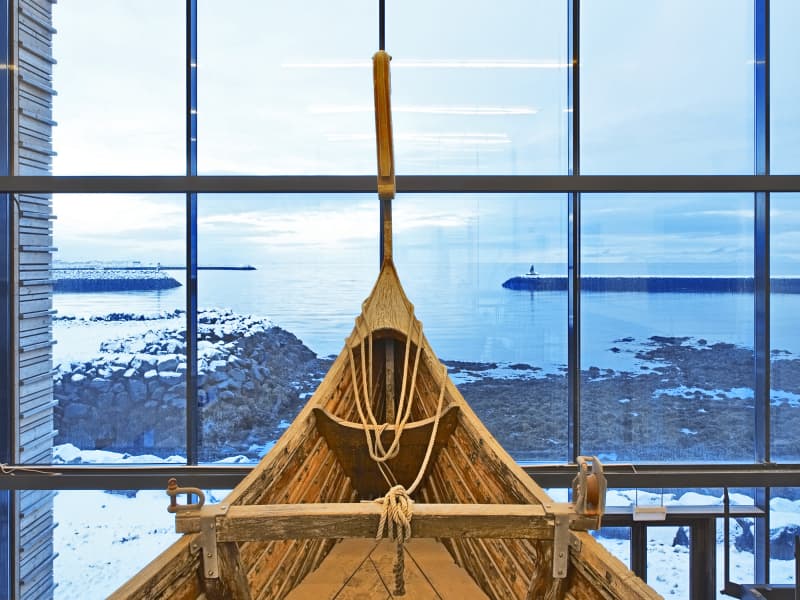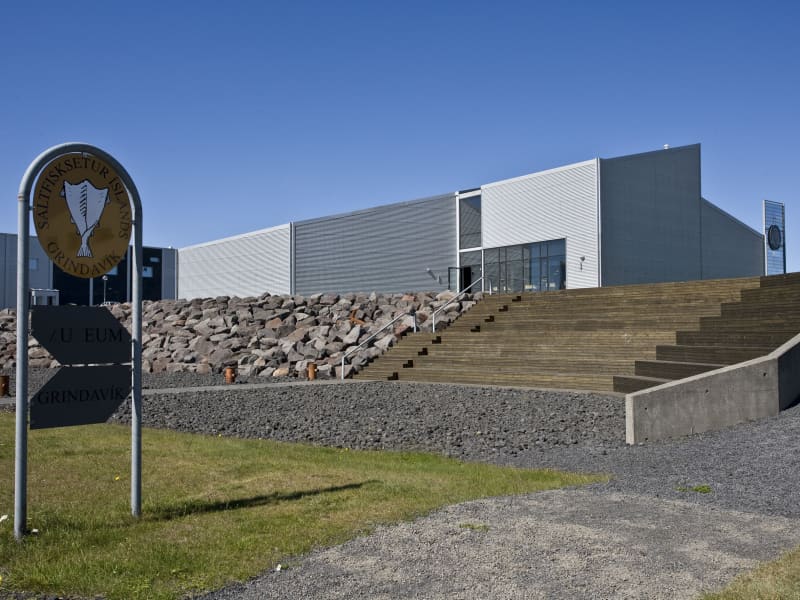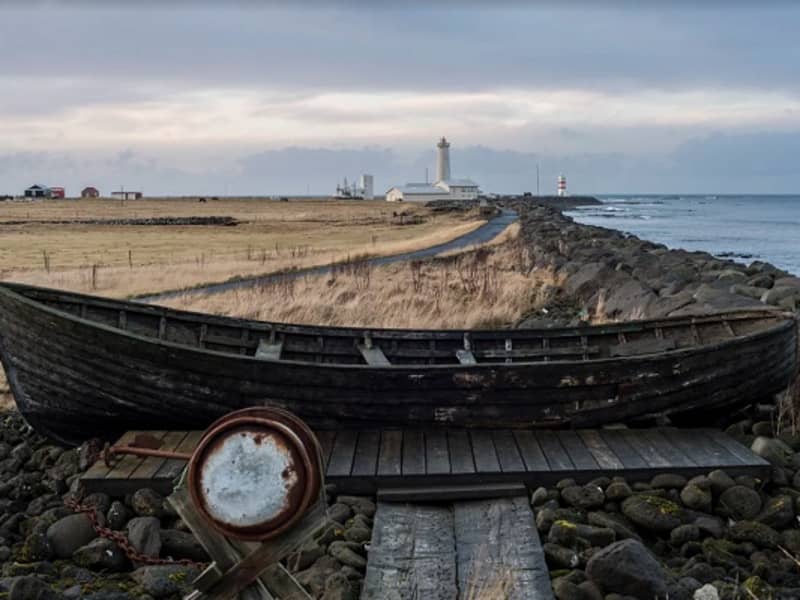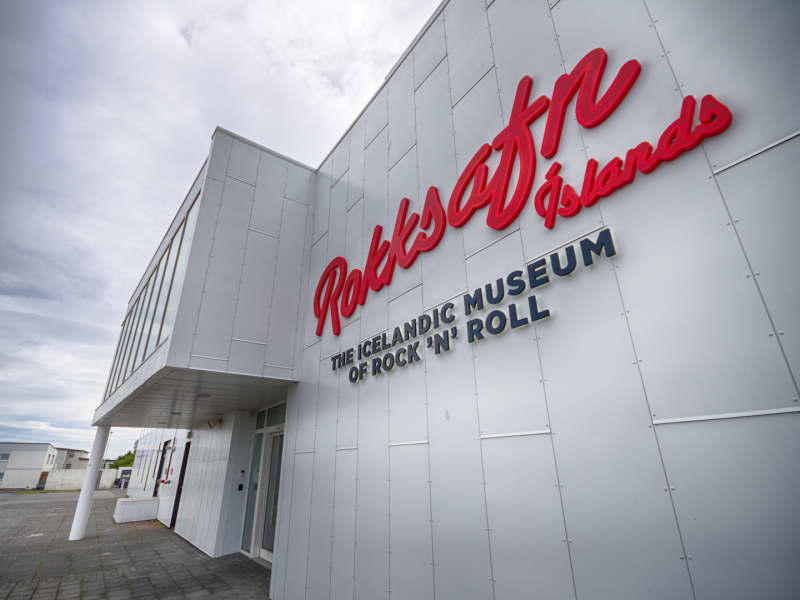Cultural centers are located in most parts of the country.
Hosting all kinds of cultural events and educational programs for people of all ages.

Hljómahöll Conference Center
Hljómahöll is a cultural and conference center in Reykjanesbær. An important forum has been created for conferences, meetings and all kinds of cultural events. The historical community house Stapi is a part of Hljómahöll which is still in full use. The Icelandic Museum of Rock ‘n’ Roll is a big part of the house (Hljómahöll) and is a great attraction for tourists all over the world who want to learn about the history of pop and rock in Iceland. The museum offers various ways to learn about this remarkable history; documentary films, music, souvenirs, an app and guests can actively involve them selves by trying out f.ex. drums, bass and guitars. In Hljómahöllin the Music School in Reykjanesbær has a new and great space for teaching and learning. With the advent of Hljómahöll we hope to see more possibilities for cultural and creative work in Reykjanes.
Halls Hljómahöll’s halls are great for various occasions, such as conferences, meetings, dance’s, birthdays, annuals, receptions after funerals etc. Please send us an e-mail and we will answer all hall related questions.
View

Viking World
Vikingaheimar is the home of the Viking Ship Íslendingur (the Icelander). Built in 1996, Icelander is an exact replica of the famous Gokstadship, a remarkable archaeological find of an almost completely intact Viking ship, excavated in Norway in 1882. Captain Gunnar Marel Eggertsson was inspired to build a replica of this beautiful ship based on his own background as shipbuilder and sailor. He copied the original nail for nail. In the year 2000, with a grant from the Leifur Eiríksson Commission of Iceland, he sailed from Iceland to New York, a journey of 4200 nautical miles. His voyage brought world-wide attention to Leif Eiriksson's and Bjarni Herjólfsson's discovery of America, dated, according to the Icelandic sagas, to exactly 1000 A.D. Building Icelander was an extraordinary achievement;at 23 metres long, 5.25 meters wide and with a holding capacity of 80 tons (by modern standards), it took 2 years of effort.The sail is 130 square meters and the mast is 18 meters in length. Made from pine and oak, scholars believe this was the most common type of ship in use during the Viking Age. Vikingaheimar is also a home to the exhibition The North Atlantic Viking Saga, originally shown at the Smithsonian Institution during the summer of 2000. Launched in Washington D.C. by King Hakon of Norway, and with a State Dinner at the White House, it then traveling to 6 other cities throughout North America. This exhibition, like the sailing of Icelander, celebrated the millennium anniversary of the Viking discovery of North America, shedding light on the latest scholarly research into the Norse settlement and explorations of unknown lands.Gunnar Marel and his crew of 8 left Iceland on Icelandic Independence day, the 17th of June, with a send off from the Prime Minister of Iceland. When it finally arrived in New York on October 5th-where it was greeted by First Lady Hillary Rodham Clinton and Mayor Rudolf Guiliani--the ship had made stops at 22 harbors. In addition to the festivities with kings, queens, presidents and mayors, when the ship arrived, visitors also streamed to see it while it was docked at each location, all told about 450,000 people came on board. These two fine projects, both celebrating Iceland's central role in the discovery of North America 1000 years ago by the Norse Vikings, have now found a permanent home in Vikinga Aldan (Viking Wave), the central building on the Vikingaheimar grounds. A spectacular modern building, it also offers beautiful views of the surrounding bay, Faxaflói.
These two fine projects, both celebrating Iceland's central role in the discovery of North America 1000 years ago by the Norse Vikings, have now found a permanent home in Vikinga Aldan (Viking Wave), the central building on the Vikingaheimar grounds. A spectacular modern building, it also offers beautiful views of the surrounding bay, Faxaflói.
View

KVIKAN - House of Culture and Natural Resources
Kvikan is the cultural house of Grindavík. Diverse cultural activities take place in Kvikan e.g., events, performances, lectures, choir rehearsals and so much more. Kvikan announces its events on its Facebook page.
On the second floor of the building is the exhibition “Saltfish in the history of the nation”. The exhibition should be interesting for foreign tourists, informative for schoolers, and enjoyable for all who want to know about the industry here.
As the 18th century progressed, and deck ships began to replace rowing ships, salted cod became Iceland's main export. Until then, wading and crawling had been the basis of foreign trade. With the advent of trawlers, salted cod processing became an important industry, and salted cod has ever since played a very significant role in the economy's performance. The exhibition takes you through the history of the salted cod and lets you experience the journey of all the stages involved to make and transport the product.
Informative:
Texts in the exhibition are in both Icelandic and English
Coffee and tea (including bathroom fee) – 250 kr.
Bathroom fee – 100 kr.
No entry fee for the exhibition
Opening hours
15. May – 31. August Every day from 11:00am – 17:00pm
1. September – 14. May Everyday but Sunday from 11:00am – 17:00pm
It is also possible for groups to come outside of opening hours by arangement.
View

Folk Museum in Garður
The municipal museum in Garðskagi is located in a natural paradise, which blends the beauty of the landscape with its rich animal and birdlife.
The museum was first opened in November 1995 in the old processing houses in Garður. The museum has both a Folk and Maritime Museum. It has an outstanding engine collection of Guðni Ingimundarson. There are over 60 engines on display and almost every one of them is functional. Many important items from the municipal history of Garður are located in the museum, items which were essential for the livelihood on both land and sea The Museum is a great point of interest for visitors as it tells the story of how fishing developed and the history of the people who lived and worked in the community. A restaurant and camping site with facilities is on-site and if you are lucky you might see dolphins and whales near the shore from the terrace of the restaurant.
Summer opening is 10-17 From the 1st May - 30. Sept.
From October the Museum can be booked for groups.
View

The Icelandic Museum of Rock ´n´ Roll
The Icelandic Museum of Rock ‘n’ Roll (Rokksafn Íslands) is a new museum about the history of popular music in Iceland. The museum was opened in 2014 and is located in Keflavik in Reykjanesbær, only a 5-minute drive away from Keflavik International airport.
The museum’s main attraction is a timeline of Iceland’s popular music history. Visitors who would like to dive deeper into the history can get an iPad guided tour to read more and listen to the music throughout Iceland’s history. Other attractions include the very popular sound lab where guests can try instruments such as an electric drum kit, electric guitar and electric bass. There’s also a karaoke singing booth where guests have the possibility to sing and record video of the themselves and send it directly to their email address or social media. Guests can also visit the museums’ cinema where documentaries about Icelandic music run all day long, try out interactive solutions to dive deeper into the history of featured artists such as Björk, Sigur Rós, Of Monsters and Men, Kaleo and many more, get an insight into what it is like to be an audio engineer on a mixing desk that features Icelandic music and visit the gift shop where there are books, DVD, CD’s and LP’s with Icelandic music along with various museum merchandise. At the museum guests can sit down, listen to the music and have a cup of coffee... or tea... or hot chocolate, whichever sounds good. The museum café offers coffee from Kaffitár which is a local roasterie, specializing in importing, roasting and serving the finest Arabica coffee beans.
The Icelandic Museum of Rock 'n' Roll is for everyone. For those who love Icelandic music and those who want to discover Icelandic Music.
Children find the sound lab particularly interesting along with the interactive parts of the museum.
The museum is open daily all year round except for New Year's Day, Good Friday, Easter Day, Christmas Eve, Christmas Day and New Year’s Eve. Opening times are 11am-6pm daily.
“The Icelandic Museum of Rock ‘n’ Roll is as eccentric in its telling as the tale it celebrates.” David Fricke, Rolling Stone.
View
